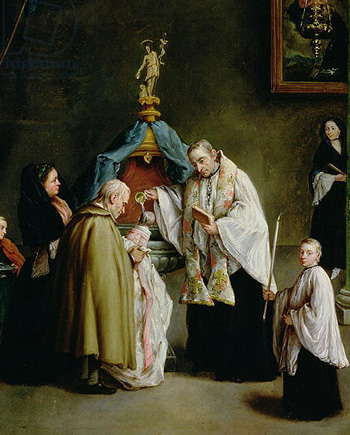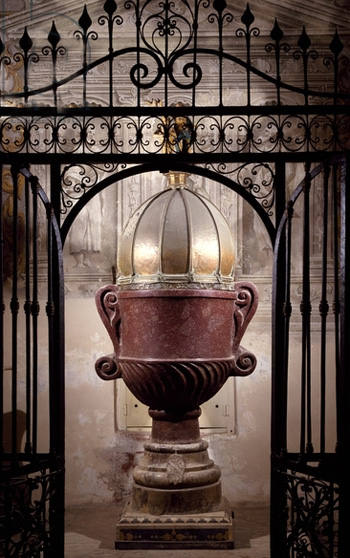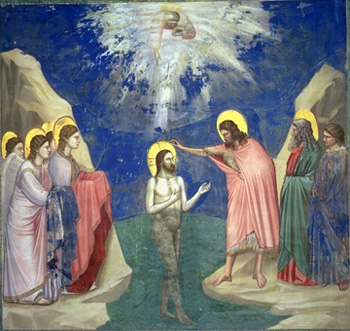About the Church
 |
 |
 |
 |
 |
 |
 |
The Sacrament of Baptism - I
General Concepts & Its Institution
Baptism is a Sacrament of the New Law instituted by Christ, (1) the purpose of which is to spiritually regenerate man and erase all sin. (2) The means used is the ablution made by water and the express invocation of the Three Persons of the Most Holy Trinity, according to the intention, formula and matter established by Holy Mother Church.
 The Major Catechism of St. Pius X teaches: "The Sacrament of Baptism confers first sanctifying grace, by which original sin is forgiven, and also any actual sins if any such exists; it remits all the penalty due on account of such sins, imprints the character of a Christian; makes us children of God, members of the Church and heirs to glory, and enables us to receive the other Sacraments." (3)
The Major Catechism of St. Pius X teaches: "The Sacrament of Baptism confers first sanctifying grace, by which original sin is forgiven, and also any actual sins if any such exists; it remits all the penalty due on account of such sins, imprints the character of a Christian; makes us children of God, members of the Church and heirs to glory, and enables us to receive the other Sacraments." (3)
The Council of Florence explicitly says: "The first place among the Sacraments belongs to Baptism, because it is the gateway to the spiritual life," (4) that is, to all the other Sacraments. For through it we receive for the first time the supernatural state of being children of God and we become members of the Catholic Church, the perfect and visible society founded on earth by Christ."
Now, Baptism, from the Greek βαπτίζω meaning "to immerse," is a Sacrament that imprints a mark or character on the soul, that is, it seals the soul with an indelible distinction that marks us as children of God.
Since the Council of Nicaea (325), it was defined that the ceremony of ablution is necessarily triple. The Council also prescribed use of the titles "Father, Son and Holy Ghost" affirming the presence of the Most Holy Trinity.
 However, this triple immersion refers to the legality, not to the validity of the ceremony, as St. Thomas explains: "The mode of washing is accidental to the Sacrament... Consequently, both single and triune immersion are lawful considered in themselves, since one immersion signifies the oneness of God, while the triune immersion signifies the Trinity of Persons.” (5)
However, this triple immersion refers to the legality, not to the validity of the ceremony, as St. Thomas explains: "The mode of washing is accidental to the Sacrament... Consequently, both single and triune immersion are lawful considered in themselves, since one immersion signifies the oneness of God, while the triune immersion signifies the Trinity of Persons.” (5)
Certainly the triple immersion is unquestionably very old in the Church and apparently of apostolic origin. It is mentioned by Tertullian, (6) St. Basil, (7) St. Eusebius Sophronius Hieronymus (8) and many other early writers. It is also worthy of note that, as early as the 7th century, the Fourth Council of Toledo approved the use of a single ablution in Baptism, as an affirmation against false trinitarian theories of the Arians, (9) who seemed to have given to triple immersion a meaning that implied three natures in the Most Holy Trinity.
To insist on the unity and same substance of the three Divine Persons, Spanish Catholics adopted one simple ablution and this symbolism had the approval of Pope Gregory the Great.
Instituted at the Baptism of Christ
Both the authors of the New Testament and some Fathers of the Church identified prefigures of Baptism in the Old Testament: The waters on which the Holy Ghost hovered in the beginning of Creation, (10) the water upon which Noah's ark floated and brought him to salvation, (11) the circumcision, (12) the passage through the Red Sea, (13) the healing of the leper Naaman by bathing in the Jordan River, (14) to name just a few.
In this sense, the Church considers that the Sacrament of Baptism was instituted in the Baptism administered by St. John the Baptist to Our Lord.
 Indeed, the Catechism of Trent clearly affirms this about the institution of the Sacrament of Baptism: “On this matter the pastors must assiduously speak. They must say that, in Baptism it is necessary to distinguish two precise moments: The first, when Our Lord instituted it; the second, when He imposed the obligation of receiving it.
Indeed, the Catechism of Trent clearly affirms this about the institution of the Sacrament of Baptism: “On this matter the pastors must assiduously speak. They must say that, in Baptism it is necessary to distinguish two precise moments: The first, when Our Lord instituted it; the second, when He imposed the obligation of receiving it.
“Regarding the first, one sees that Our Lord instituted this Sacrament when He conferred to the water the virtue of sanctifying, on the occasion wherein He made himself be baptized by John. St. Gregory Nazianzen and St. Augustine say that in that moment the water acquired the power of regenerating to spiritual life.
"In another place, St. Augustine writes: ‘From the moment that Christ is immersed in water, water washes away all sins.’ And elsewhere: ‘Our Lord is baptized not because He had need to be cleansed, but in order that, by the contact of His most holy Body, He might purify the waters and impart to them the power of cleansing. …
“About the second moment, when the law of Baptism was promulgated, it also admits of no doubt. Church writers are unanimous in saying that it was after the Resurrection of Our Lord, when He gave to the Apostles the command to go and teach all nations: baptizing them in the name of the Father, and of the Son, and of the Holy Ghost. Thenceforth, the law of Baptism became obligatory on all who were to attain eternal salvation.” (15)
So, the Baptism was instituted in the Baptism of Our Lord, and it was confirmed when He ordered the Apostles to go and baptize all. Since this is a point that many American Catholics see differently, I wanted to make this point very clear as I start to deal with Baptism.
With these presuppositions, I end this first article of a series that promises to be long.
Continued


A typical Catholic Baptism: the priest pours the water over the infant's head
The Council of Florence explicitly says: "The first place among the Sacraments belongs to Baptism, because it is the gateway to the spiritual life," (4) that is, to all the other Sacraments. For through it we receive for the first time the supernatural state of being children of God and we become members of the Catholic Church, the perfect and visible society founded on earth by Christ."
Now, Baptism, from the Greek βαπτίζω meaning "to immerse," is a Sacrament that imprints a mark or character on the soul, that is, it seals the soul with an indelible distinction that marks us as children of God.
Since the Council of Nicaea (325), it was defined that the ceremony of ablution is necessarily triple. The Council also prescribed use of the titles "Father, Son and Holy Ghost" affirming the presence of the Most Holy Trinity.

A 9th century baptismal font in Amalfi Cathedral, Italy
Certainly the triple immersion is unquestionably very old in the Church and apparently of apostolic origin. It is mentioned by Tertullian, (6) St. Basil, (7) St. Eusebius Sophronius Hieronymus (8) and many other early writers. It is also worthy of note that, as early as the 7th century, the Fourth Council of Toledo approved the use of a single ablution in Baptism, as an affirmation against false trinitarian theories of the Arians, (9) who seemed to have given to triple immersion a meaning that implied three natures in the Most Holy Trinity.
To insist on the unity and same substance of the three Divine Persons, Spanish Catholics adopted one simple ablution and this symbolism had the approval of Pope Gregory the Great.
Instituted at the Baptism of Christ
Both the authors of the New Testament and some Fathers of the Church identified prefigures of Baptism in the Old Testament: The waters on which the Holy Ghost hovered in the beginning of Creation, (10) the water upon which Noah's ark floated and brought him to salvation, (11) the circumcision, (12) the passage through the Red Sea, (13) the healing of the leper Naaman by bathing in the Jordan River, (14) to name just a few.
In this sense, the Church considers that the Sacrament of Baptism was instituted in the Baptism administered by St. John the Baptist to Our Lord.

Giotto's Baptism of Christ in the River Jordan
“Regarding the first, one sees that Our Lord instituted this Sacrament when He conferred to the water the virtue of sanctifying, on the occasion wherein He made himself be baptized by John. St. Gregory Nazianzen and St. Augustine say that in that moment the water acquired the power of regenerating to spiritual life.
"In another place, St. Augustine writes: ‘From the moment that Christ is immersed in water, water washes away all sins.’ And elsewhere: ‘Our Lord is baptized not because He had need to be cleansed, but in order that, by the contact of His most holy Body, He might purify the waters and impart to them the power of cleansing. …
“About the second moment, when the law of Baptism was promulgated, it also admits of no doubt. Church writers are unanimous in saying that it was after the Resurrection of Our Lord, when He gave to the Apostles the command to go and teach all nations: baptizing them in the name of the Father, and of the Son, and of the Holy Ghost. Thenceforth, the law of Baptism became obligatory on all who were to attain eternal salvation.” (15)
So, the Baptism was instituted in the Baptism of Our Lord, and it was confirmed when He ordered the Apostles to go and baptize all. Since this is a point that many American Catholics see differently, I wanted to make this point very clear as I start to deal with Baptism.
With these presuppositions, I end this first article of a series that promises to be long.
Continued
- DS 1601
- DS 1512
- St.Pío X, Maior Catechism, 552
- DS 1314
- Sancti Thomae de Aquino, Summa Theologiae, (Torino: Edizioni Paoline, 1988) P. III, q. 66. a 8.
- De cor. Milit., III
- De Sp. S., XXVII
- Dial. contra Luc., VIII
- San Gregorio Magno, Epist. ad Leand., 3 Hispana, PL. 84, 834.
- Gn. 1:2
- 1 P 3:20-21
- Col 2:11-12
- 1 Col 10:2
- 2 Kings 5:14
- Council of Trent, Catechism for the Parish Priests, Part II, Baptism, VIII, 1, 2.§§ 20, 21.

Posted December 15, 2017















